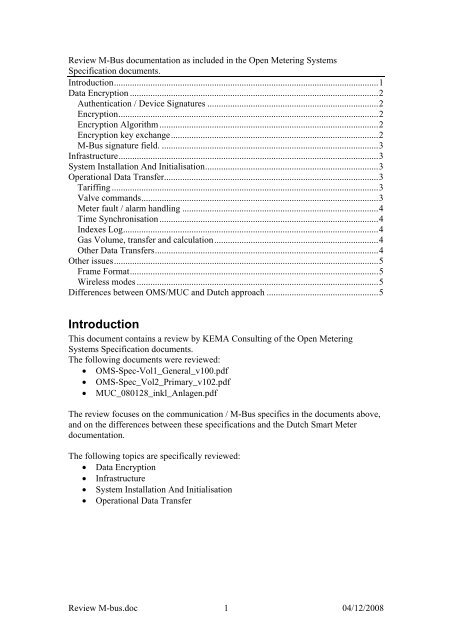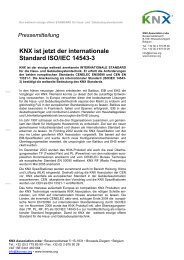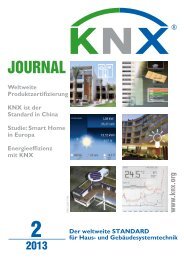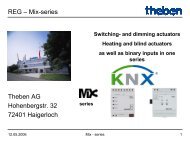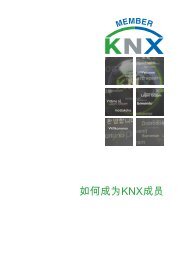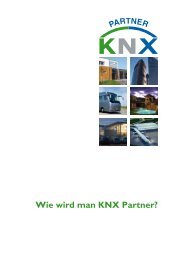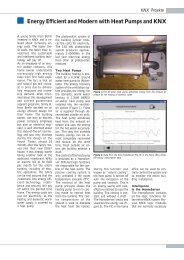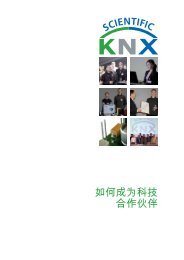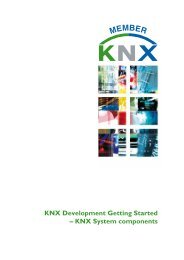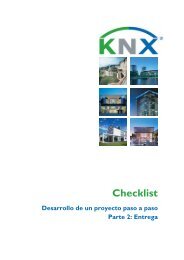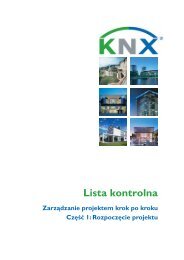Introduction - KNX
Introduction - KNX
Introduction - KNX
You also want an ePaper? Increase the reach of your titles
YUMPU automatically turns print PDFs into web optimized ePapers that Google loves.
Review M-Bus documentation as included in the Open Metering Systems<br />
Specification documents.<br />
<strong>Introduction</strong>....................................................................................................................1<br />
Data Encryption .............................................................................................................2<br />
Authentication / Device Signatures ...........................................................................2<br />
Encryption..................................................................................................................2<br />
Encryption Algorithm ................................................................................................2<br />
Encryption key exchange...........................................................................................2<br />
M-Bus signature field. ...............................................................................................3<br />
Infrastructure..................................................................................................................3<br />
System Installation And Initialisation............................................................................3<br />
Operational Data Transfer..............................................................................................3<br />
Tariffing .....................................................................................................................3<br />
Valve commands........................................................................................................3<br />
Meter fault / alarm handling ......................................................................................4<br />
Time Synchronisation ................................................................................................4<br />
Indexes Log................................................................................................................4<br />
Gas Volume, transfer and calculation........................................................................4<br />
Other Data Transfers..................................................................................................4<br />
Other issues....................................................................................................................5<br />
Frame Format.............................................................................................................5<br />
Wireless modes ..........................................................................................................5<br />
Differences between OMS/MUC and Dutch approach .................................................5<br />
<strong>Introduction</strong><br />
This document contains a review by KEMA Consulting of the Open Metering<br />
Systems Specification documents.<br />
The following documents were reviewed:<br />
• OMS-Spec-Vol1_General_v100.pdf<br />
• OMS-Spec_Vol2_Primary_v102.pdf<br />
• MUC_080128_inkl_Anlagen.pdf<br />
The review focuses on the communication / M-Bus specifics in the documents above,<br />
and on the differences between these specifications and the Dutch Smart Meter<br />
documentation.<br />
The following topics are specifically reviewed:<br />
• Data Encryption<br />
• Infrastructure<br />
• System Installation And Initialisation<br />
• Operational Data Transfer<br />
Review M-bus.doc 1 04/12/2008
Data Encryption<br />
Authentication / Device Signatures<br />
Signatures, or authentication in any way, are not included in the Dutch smart meter<br />
specifications. This is referred to in the OMS documents (OMS-Spec-<br />
Vol1_General_v100.pdf section 3.6.2) as work in progress.<br />
Encryption<br />
The Dutch smart meter specifications require two-way data encryption. The MUC to<br />
Meter data may contain control data (time synch, valve control, etc) so should be<br />
encrypted. The Meter to MUC data should be encrypted for privacy reasons (to mask<br />
zero or low consumption of temporarily uninhabited quarters).<br />
The MUC documents require only encryption for MUC to Meter data<br />
(MUC_080128_inkl_Anlagen.pdf SRR section 5.3.9).<br />
Note that the EN13757 only specifies encryption for Meter to MUC data.<br />
Encryption Algorithm<br />
The encryption algorithm is in both the Dutch smart meter specification and the OMS<br />
documents AES-128.<br />
The block chaining mode is in both specification documents CBC (Cipher Block<br />
Chaining).<br />
In the Dutch specification, the initialisation vector is binary zero, in the OMS<br />
specification the initialisation vector (IV) is built from data that is sent (in the same<br />
transaction as are the encrypted data) as unencrypted byte stream.<br />
Encryption key exchange<br />
In the Dutch smart meter specifications, a new encryption key is encrypted with a<br />
meter-specific default encryption key to prevent exchange of an unencrypted plaintext<br />
encryption key. This allows a relatively secure modification of encryption keys.<br />
In the OMS documents there is no exchange of encryption keys; hence changing<br />
encryption keys in an operational meter is not possible. The encryption keys in the<br />
OMS specification are configured in the production facility. The encryption key is<br />
then sent unencrypted from the meter to the MUC, and from there to the Head End,<br />
during installation. (MUC_080128_inkl_Anlagen.pdf SRR section 5.3.9).<br />
Comments:<br />
Review M-bus.doc 2 04/12/2008
• Does this mean that a “rogue” MUC can inquire with a meter and receive its<br />
encryption key?<br />
• How is the installation process initiated?<br />
M-Bus signature field.<br />
The M-Bus signature field (EN 13757-3 section 5.10) is modified to support the AES<br />
128 encryption algorithm. The OMS documents (OMS-Spec_Vol2_Primary_v102.pdf<br />
section 4.2.2.2) however include the Hop Counter in the LSB of the signature field, to<br />
support repeater functionality in wireless networks. We are not sure if this<br />
implementation is according to the (preliminary) EN-13757-5 standard (ref also<br />
OMS-Spec_Vol2_Primary_v102.pdf section 2.2.1). The Dutch Smart meter<br />
documents do not support repeater or relaying functionality in wireless networks, and<br />
strictly follow the signature definitions in EN 13757-3 section 5.10.<br />
Infrastructure<br />
In the Dutch Smart Meter documents, the Electricity meter is built into the MUC<br />
gateway. This means the option to exchange electricity data over the M-Bus<br />
connection is not specified.<br />
In the MUC specification, the MUC and the Electricity meter are separate objects, and<br />
the exchange of E-data is described. This allows for a more flexible approach.<br />
System Installation And Initialisation<br />
The Dutch smart meter documents include detailed specifications of initialising<br />
connections. Specifically the binding of newly installed wireless meters to a MUC is<br />
described in detail.<br />
This is not included in the OMS specifications.<br />
Operational Data Transfer<br />
Tariffing<br />
The Dutch smart meter specification does not include exchange of tariff data. The<br />
OMS documents do (OMS-Spec-Vol1_General_v100.pdf section 3.7 and<br />
MUC_080128_inkl_Anlagen.pdf section 3).<br />
This means the Dutch meters can not display tariff or cost indications, just<br />
consumption data consisting of measured or calculated data.<br />
Valve commands<br />
Valve commands and Valve status reporting are handled differently in the Dutch and<br />
MUC documents (MUC_080128_inkl_Anlagen.pdf section 5.2.3) :<br />
Dutch definition<br />
German definition<br />
DIF 01H 89H<br />
VIF FDH FDH<br />
VIFE 1FH 1AH<br />
Review M-bus.doc 3 04/12/2008
Contents<br />
00 – closed<br />
01 – opened<br />
02 – released (ready to<br />
open)<br />
00 – closed<br />
01 – opened<br />
02 – released (ready to<br />
open)<br />
03 – moving<br />
04 - ready<br />
The Dutch approach is to refer to the valve as remotely controlled device; the MUC<br />
approach is to refer to the valve as Digital Output.<br />
Note that in the German approach I personally would have selected “Digital Input”<br />
(VIFE=1BH) for valve status (MUC_080128_inkl_Anlagen.pdf SRR section 5.3.4).<br />
Meter fault / alarm handling<br />
(MUC_080128_inkl_Anlagen.pdf section 5.2.4)<br />
The extended error flag (German definition DIF=n4H, VIF=FDH, VIFE=17H) is not<br />
used in the Dutch version. The error flag in the Data Header is used in the Dutch<br />
version. This limits the number of errors in the Dutch definition to eight bits, five of<br />
which are predefined.<br />
Time Synchronisation<br />
The Dutch smart meter specifications include time synchronisation. Whether or not<br />
Daylight Savings Time is used is up to the grid company managing the meter.<br />
The MUC documents include Summer/Wintertime (DST) updates<br />
(MUC_080128_inkl_Anlagen.pdf SRR section 5.2.5).<br />
Indexes Log<br />
(MUC_080128_inkl_Anlagen.pdf SRR section 5.2.8).<br />
In the Dutch smart meter specifications, the M-Bus devices (meters) do not maintain<br />
logging. The MUC maintains all historic logs, meters transfer current measured data.<br />
The indexes log functions are therefore not used in the Dutch version.<br />
Gas Volume, transfer and calculation<br />
OMS chooses to Define a new gas metering device to enable transfer of corrected<br />
volumes (OMS-Spec_Vol2_Primary_v102.pdf section 4.3.1). In our opinion, the<br />
device is still a regular gas meter; however the data item is different. We choose to<br />
define a new DIF/VIF combination to signify corrected gas volumes. This would, in<br />
theory and in future systems, also allow the transfer of both corrected and uncorrected<br />
volumes by one single M-Bus device (MUC_080128_inkl_Anlagen.pdf SRR section<br />
5.3.2).<br />
Other Data Transfers<br />
The Dutch Smart meter specifications do not define large storage indexes for metered<br />
data, however the meter reading of the previous full hour is stored as storage index<br />
#1. The is never more than one measured value stored in the Dutch meters. In the<br />
MUC documents, measurement and reading logs are defined<br />
(MUC_080128_inkl_Anlagen.pdf SRR section 5.4).<br />
Review M-bus.doc 4 04/12/2008
Other issues<br />
Frame Format<br />
The MUC_080128_inkl_Anlagen.pdf SRR section 5, ANNEX A: WIRELESS M-<br />
BUS MESSAGES, refers to the FT1.2 message format. For all wireless transmissions<br />
the FT3 message format should be used. This is corrected in the OMS-Spec-<br />
Vol1_General_v100.pdf and OMS-Spec_Vol2_Primary_v102.pdf.<br />
Wireless modes<br />
I strongly suggest to choose between S2 and T2 modes for wireless transmissions.<br />
Leaving the choice open will probably not help much in designing interoperable<br />
systems. (MUC_080128_inkl_Anlagen.pdf SRR section 3.1).<br />
Differences between OMS/MUC and Dutch approach 1<br />
Topic RWE spec Dutch spec<br />
Identification<br />
Serial Number R/W R - Header<br />
Meter Type R R - Header<br />
Manufacturer text R -<br />
Manufactured date R -<br />
Volume / Tariff<br />
Volume Index Corrected W -<br />
Volume Index with Active Tariff R -<br />
New Tariff – Effective date/time W -<br />
Valve<br />
Valve State R/W R/W<br />
Valve Number of Closes R -<br />
Battery<br />
Remaining Battery Days R - 2<br />
System State<br />
Date and Time R/W R/W<br />
Time Synchronisation Offset W -<br />
Extended Error Flag R/W -<br />
Daylight Saving R/W -<br />
Information Transfer<br />
Meter Information Request R -<br />
Transparent Information R/W -<br />
Configuration<br />
Time between RF polls R/W - 3<br />
1 Note that the Dutch specification explicitly specifies that all DIF/VIF codes in the EN13757-3 can be<br />
exchanged. It is likely that some data objects do not contain useful information, but technically they<br />
can be exchanged. In this table we only refer to data objects that will contain “defined and useful data”.<br />
2 Calculated in MUC<br />
Review M-bus.doc 5 04/12/2008
Topic RWE spec Dutch spec<br />
Number of days of non-communication R/W -<br />
Encryption Key Exchange R/W 4 W<br />
Data<br />
Metered value, actual R R<br />
Metered value, previous hour R R<br />
3 Fixed value.<br />
4 One-Time in production facility. No key changes allowed in online systems.<br />
Review M-bus.doc 6 04/12/2008


